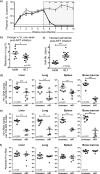HIV persistence in tissue macrophages of humanized myeloid-only mice during antiretroviral therapy
- PMID: 28414330
- PMCID: PMC5419854
- DOI: 10.1038/nm.4319
HIV persistence in tissue macrophages of humanized myeloid-only mice during antiretroviral therapy
Abstract
Despite years of fully suppressive antiretroviral therapy (ART), HIV persists in its hosts and is never eradicated. One major barrier to eradication is that the virus infects multiple cell types that may individually contribute to HIV persistence. Tissue macrophages are critical contributors to HIV pathogenesis; however, their specific role in HIV persistence during long-term suppressive ART has not been established. Using humanized myeloid-only mice (MoM), we demonstrate that HIV infection of tissue macrophages is rapidly suppressed by ART, as reflected by a rapid drop in plasma viral load and a dramatic decrease in the levels of cell-associated viral RNA and DNA. No viral rebound was observed in the plasma of 67% of the ART-treated animals at 7 weeks after ART interruption, and no replication-competent virus was rescued from the tissue macrophages obtained from these animals. In contrast, in a subset of animals (∼33%), a delayed viral rebound was observed that is consistent with the establishment of persistent infection in tissue macrophages. These observations represent the first direct evidence, to our knowledge, of HIV persistence in tissue macrophages in vivo.
Conflict of interest statement
The authors have no competing interests as defined by Springer Nature, or other interests that might be perceived to influence the results and/or discussion reported in this paper.
Figures



Comment in
-
HIV persistence in macrophages.Nat Med. 2017 May 5;23(5):538-539. doi: 10.1038/nm.4337. Nat Med. 2017. PMID: 28475569 No abstract available.
-
Viral pathogenesis: Masked by macrophages.Nat Rev Microbiol. 2017 May 12;15(6):320-321. doi: 10.1038/nrmicro.2017.52. Nat Rev Microbiol. 2017. PMID: 28496162 No abstract available.
References
-
- Collman RG, Perno CF, Crowe SM, Stevenson M, Montaner LJ. HIV and cells of macrophage/dendritic lineage and other non-T cell reservoirs: new answers yield new questions. J Leukoc Biol. 2003;74:631–634. - PubMed
MeSH terms
Substances
Grants and funding
LinkOut - more resources
Full Text Sources
Other Literature Sources
Medical

